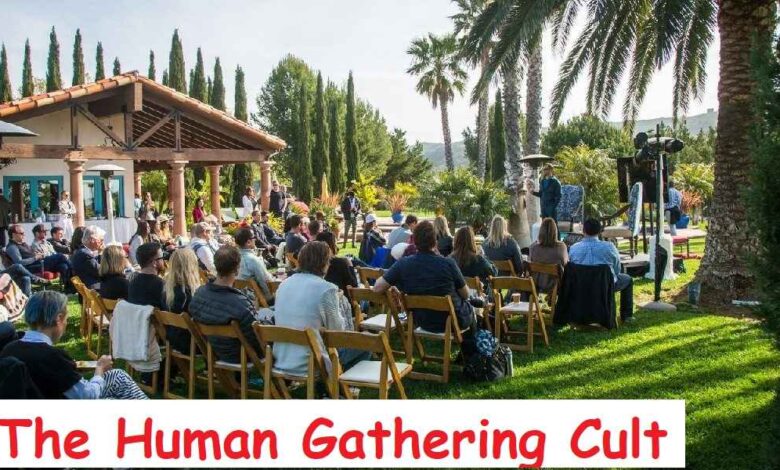The Human Gathering Cult: Unveiling the Mysteries Behind a Controversial Community

Introduction
The Human Gathering Cult has emerged as a topic of intrigue and controversy in contemporary discussions about unconventional communities. This cult, often misunderstood, has its roots in a quest for belonging, spirituality, and shared values. In an era marked by a profound search for identity and community, understanding such groups is vital for fostering awareness and empathy. This article delves deep into the Human Gathering Cult, exploring its beliefs, practices, community dynamics, and the societal perceptions that surround it.
In an increasingly interconnected world, the appeal of alternative communities can be attributed to various factors, including disillusionment with mainstream society, the desire for personal transformation, and the need for social support. By shedding light on the Human Gathering Cult, we aim to provide insights into its inner workings and the motivations behind its formation. This exploration is not just about the cult itself but serves as a broader commentary on human nature, community, and the lengths individuals go to find their place in the world.
Through this comprehensive examination, we will uncover the complexities of the Human Gathering Cult, dispelling myths and providing an informed perspective. From its historical background to its representation in popular culture, the cult is a multifaceted subject that warrants careful consideration and understanding.
1. Understanding the Human Gathering Cult
1.1 Definition of the Cult
The term “cult” often carries negative connotations, suggesting secrecy, manipulation, and exploitation. However, to truly understand the Human Gathering Cult, we must first define what constitutes a cult in a broader context. A cult is typically characterized by a group of people who share a set of beliefs or practices that diverge from mainstream society, often led by charismatic leaders. In many cases, cults provide a sense of belonging and purpose to their members, fulfilling emotional and spiritual needs that may be unmet elsewhere.
The Human Gathering Cult embodies these characteristics but also seeks to redefine the notion of community in a way that encourages personal growth and collective support. Its members are united by a shared vision of enlightenment and connection, emphasizing the importance of gathering for mutual understanding and personal development. The cult’s practices often revolve around communal activities, discussions, and rituals aimed at fostering unity and spiritual awakening.
Understanding the Human Gathering Cult as a legitimate community seeking to explore deeper philosophical and existential questions allows for a more nuanced perspective. While it may exhibit some cult-like traits, such as a strong leader and a closed community, its underlying motivations are rooted in a desire for connection and shared experiences rather than manipulation or control.
1.2 Historical Background
The origins of the Human Gathering Cult can be traced back to the late 20th century, a time marked by significant social and cultural upheaval. In response to increasing disconnection in modern society, a group of like-minded individuals came together to form a community that would challenge conventional norms and explore alternative ways of living. The founding members sought to create a space where individuals could come together, share their experiences, and support one another in their personal journeys.
Key figures in the establishment of the Human Gathering Cult included philosophers, spiritual leaders, and individuals disillusioned with mainstream religious practices. These founders aimed to cultivate an environment that emphasized personal exploration, emotional support, and collective growth. Over the years, the cult has evolved, attracting a diverse array of individuals from various backgrounds, each seeking a sense of belonging and purpose.
A timeline of significant events in the cult’s history highlights its development. From its inception to its expansion in the early 2000s, the Human Gathering Cult has adapted to changing societal dynamics while maintaining its core beliefs. Notable milestones include the establishment of community centers, the organization of large gatherings, and the publication of literature that articulates its philosophy. These developments have contributed to its identity as a unique and resilient community, fostering connections among individuals seeking deeper meaning in their lives.
1.3 Core Beliefs and Practices
At the heart of the Human Gathering Cult lies a set of core beliefs that shape its identity and practices. Central to these beliefs is the idea that individuals can achieve personal transformation through communal support and shared experiences. Members of the cult are encouraged to explore their spirituality, question societal norms, and seek deeper connections with themselves and others.
Rituals and ceremonies play a significant role in the Human Gathering Cult’s practices. These gatherings often involve meditation, group discussions, and activities designed to promote self-discovery and personal growth. Members participate in these rituals not only to connect with one another but also to engage in collective introspection, fostering an environment of trust and openness. By sharing their stories and experiences, members create a safe space for vulnerability and growth.
A notable aspect of the Human Gathering Cult is its emphasis on inclusivity and acceptance. Unlike many traditional religious groups, the cult encourages individuals to explore their beliefs without fear of judgment. This open-minded approach fosters a sense of belonging, allowing members to express their unique perspectives and experiences. By prioritizing communal support and personal exploration, the Human Gathering Cult aims to create a transformative environment that empowers individuals to embark on their spiritual journeys.
2. Community Structure and Dynamics
2.1 Leadership Hierarchy
The leadership structure within the Human Gathering Cult is characterized by a blend of charisma and communal participation. While a few individuals often emerge as prominent leaders, the emphasis is placed on collective decision-making and shared responsibility. Leaders are typically chosen based on their ability to inspire and connect with members, serving as facilitators of discussions and guiding the community’s direction.
This leadership model allows for a dynamic relationship between leaders and members. Instead of enforcing rigid rules or dogmas, leaders foster an environment where open communication and collaboration are encouraged. Members are empowered to contribute their ideas, experiences, and suggestions, ensuring that the community evolves in response to its members’ needs and aspirations.
The fluidity of the leadership structure also mitigates the risks often associated with cults, such as authoritarian control and manipulation. By prioritizing collective input and shared goals, the Human Gathering Cult creates a space where individuals feel valued and heard. This participatory approach fosters a sense of ownership among members, contributing to the community’s resilience and adaptability over time.
2.2 Membership and Recruitment
Joining the Human Gathering Cult is often seen as a personal journey rather than a formalized process. Interested individuals typically learn about the cult through word-of-mouth, social media, or community events. The cult encourages a welcoming atmosphere, where newcomers are invited to attend gatherings and participate in discussions before fully committing to membership.
The demographics of members within the Human Gathering Cult are diverse, spanning various age groups, backgrounds, and experiences. Many members are individuals who have experienced disillusionment with mainstream society or traditional religious institutions. They are drawn to the cult’s promise of connection, understanding, and personal growth. As such, the cult has become a refuge for those seeking a sense of belonging and purpose.
Recruitment techniques employed by the Human Gathering Cult are rooted in authenticity and personal connection. Rather than relying on coercive tactics, the cult encourages organic relationships to develop among members. This approach fosters trust and camaraderie, making it easier for individuals to feel comfortable exploring their spirituality within the community. Through this emphasis on genuine connection, the cult continues to attract individuals who resonate with its philosophy and values.
2.3 Daily Life of Members
The daily life of members within the Human Gathering Cult is shaped by the community’s core beliefs and practices. Members engage in various activities that promote personal growth, communal support, and spiritual exploration. Daily routines often include meditation, group discussions, and creative expression, allowing individuals to connect with themselves and their fellow members on a deeper level.
Rules and regulations within the cult are typically centered around mutual respect, openness, and accountability. Members are encouraged to hold themselves and each other accountable for their actions and choices, fostering an environment of trust and integrity. This culture of support empowers individuals to share their struggles and triumphs, creating a strong sense of community and belonging.
The impact of cult membership on personal relationships and family dynamics can be complex. While many members find deep connections and support within the community, they may also face challenges in their relationships with non-member family and friends. Striking a balance between their commitment to the cult and maintaining connections with the outside world requires ongoing communication and understanding. By navigating these dynamics with care, members can foster healthy relationships both within and outside the cult.
3. Controversies and Criticisms
3.1 Public Perception
The Human Gathering Cult, like many unconventional communities, faces scrutiny and criticism from the broader public. Media portrayals and sensationalized accounts often shape public perception, leading to misconceptions about the cult’s beliefs and practices. Many people view the cult through a lens of skepticism, associating it with secrecy, manipulation, and exploitation.
However, it is essential to approach the subject with nuance and an understanding of the cult’s genuine intentions. The Human Gathering Cult is often misunderstood due to its alternative nature, and the fears surrounding it can stem from a lack of knowledge about its beliefs and practices. Engaging with members and learning about their experiences can help dispel myths and foster a more informed perspective on the cult.
Furthermore, the rise of the internet and social media has amplified both support and criticism of the Human Gathering Cult. Online platforms provide spaces for individuals to share their experiences, both positive and negative. While some former members may speak out against the cult, highlighting harmful aspects of their experiences, others share stories of personal transformation and growth. This diverse array of perspectives contributes to an ongoing dialogue about the cult’s role in contemporary society.
3.2 Legal Issues and Investigations
Legal challenges and investigations surrounding the Human Gathering Cult have contributed to its controversial reputation. Like many cults, it has faced allegations of misconduct, including claims of manipulation, emotional abuse, and financial exploitation. These accusations have often led to heightened scrutiny from law enforcement and social services, raising questions about the cult’s practices and treatment of members.
Despite these challenges, the cult has maintained a degree of resilience. In many cases, legal investigations have resulted in no formal charges, highlighting the complexities of navigating allegations against alternative communities. Members often defend the cult, asserting that the accusations stem from misunderstandings or biases against unconventional lifestyles.
The Human Gathering Cult’s ability to weather legal scrutiny speaks to its commitment to fostering a supportive and open environment. While it is crucial to address legitimate concerns, it is equally important to recognize the community’s efforts to promote personal growth and collective empowerment. By engaging in transparent dialogue and addressing allegations head-on, the cult seeks to dispel fears and build trust within and outside the community.
3.3 The Psychological Impact on Members
The psychological effects of cult membership can be profound, shaping individuals’ identities, relationships, and worldviews. For many members of the Human Gathering Cult, joining the community represents a turning point in their lives—a chance to escape feelings of isolation and disconnection. The sense of belonging and support provided by the cult can lead to significant personal transformation, fostering emotional resilience and a renewed sense of purpose.
However, leaving the cult can also present challenges. Former members often grapple with feelings of loss, confusion, and identity crisis as they navigate their newfound independence. The process of deprogramming—reassessing beliefs, values, and relationships—can be difficult, requiring support and resources to facilitate healing and recovery.
Recognizing the psychological impact of cult membership is essential for fostering understanding and empathy toward former members. Support systems, including therapy and community groups, can provide invaluable resources for individuals seeking to reintegrate into society. By acknowledging the complexities of cult membership and its aftermath, we can promote awareness and compassion for those who have experienced the Human Gathering Cult’s unique challenges.
4. The Human Gathering Cult in Popular Culture
4.1 Representation in Media
The portrayal of the Human Gathering Cult in popular media has played a significant role in shaping public perceptions. Documentaries, films, and books that focus on the cult often highlight its controversial aspects, emphasizing the allure and dangers of alternative communities. While these representations can serve as cautionary tales, they may also oversimplify the cult’s beliefs and practices, reducing a complex community to sensationalized narratives.
One notable example of media representation is the documentary series that explores the lives of cult members and their experiences. These narratives provide valuable insights into the motivations and struggles of individuals within the cult, offering a more nuanced perspective on their journeys. By showcasing personal stories, these films can humanize members and challenge stereotypes, encouraging viewers to approach the cult with empathy and understanding.
Moreover, fictional depictions of cults in literature and film often draw inspiration from real-life communities like the Human Gathering Cult. These portrayals can serve as allegories for broader societal issues, exploring themes of belonging, identity, and the search for meaning in an increasingly fragmented world. While they may not accurately represent the cult, such narratives can provoke thought and discussion about the nature of community and the human experience.
4.2 Influence on Art and Literature
The influence of the Human Gathering Cult extends beyond traditional media into the realm of art and literature. Artists and writers often draw inspiration from alternative communities, exploring themes of spirituality, connection, and personal transformation. This creative expression can provide a platform for dialogue about the complexities of human relationships and the search for identity.
Visual artists may depict scenes from cult gatherings, highlighting the communal aspects of these experiences. Through their work, they capture the emotional intensity and depth of connection that members often experience within the Human Gathering Cult. Such representations can evoke empathy and provoke reflection on the human desire for belonging and understanding.
Literature also serves as a powerful medium for exploring the nuances of cult life. Authors may use fictional narratives to delve into the psychology of cult membership, examining the motivations and struggles of characters within alternative communities. These stories can provide insights into the emotional landscapes of individuals seeking connection and meaning, fostering a deeper understanding of the complexities of cult membership.
4.3 Current Relevance
As society continues to evolve, the Human Gathering Cult remains relevant in contemporary discussions about community, belonging, and spirituality. In an increasingly fragmented world, many individuals seek alternatives to traditional institutions, exploring the potential of unconventional communities to fulfill their emotional and spiritual needs. The cult’s emphasis on connection and personal growth resonates with those disillusioned by mainstream society, offering a refuge for individuals seeking a deeper sense of purpose.
Moreover, the cult’s adaptability to changing societal dynamics reflects its resilience and commitment to fostering a supportive environment. As new generations grapple with the challenges of modern life, the Human Gathering Cult provides a space for exploration, connection, and shared experiences. By embracing inclusivity and open dialogue, the cult seeks to evolve alongside its members, ensuring that it remains a relevant and empowering community.
In the face of criticism and scrutiny, the Human Gathering Cult continues to advocate for understanding and acceptance. By engaging in transparent discussions about its beliefs and practices, the cult aims to dispel misconceptions and foster a more informed perspective on alternative communities. As we navigate an increasingly complex world, the lessons learned from the Human Gathering Cult can inspire us to embrace diversity, compassion, and the quest for genuine connection.
Conclusion
The Human Gathering Cult presents a fascinating case study of contemporary community dynamics and the human search for belonging and purpose. By examining its historical background, beliefs, practices, and community structure, we gain valuable insights into the motivations behind its formation and the experiences of its members. While controversies and criticisms surround the cult, it is essential to approach the subject with nuance and empathy, recognizing the complexities of human relationships and the desire for connection.
As we reflect on the significance of understanding the Human Gathering Cult, we are reminded of the broader implications for society. By engaging with alternative communities, we can foster dialogue and understanding, challenging stereotypes and promoting acceptance. The lessons learned from the Human Gathering Cult encourage us to embrace diversity, explore our spiritual journeys, and seek genuine connections with one another in an increasingly interconnected world.




